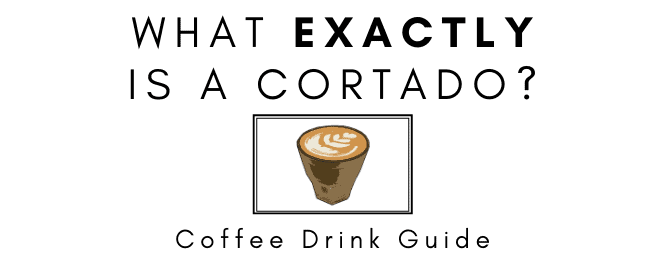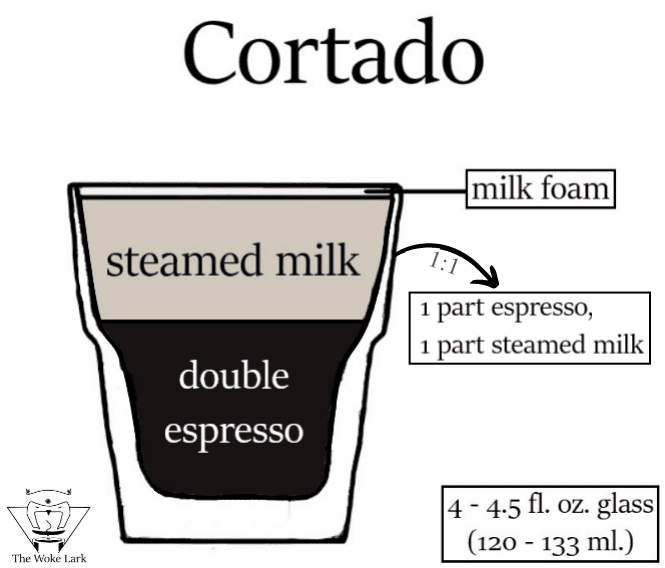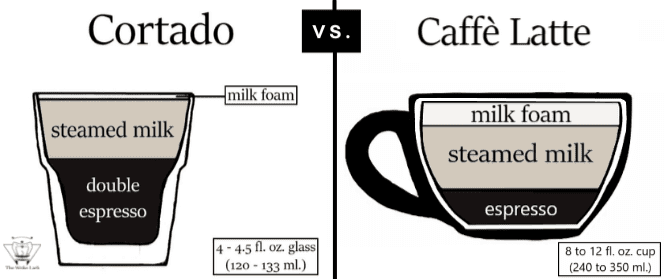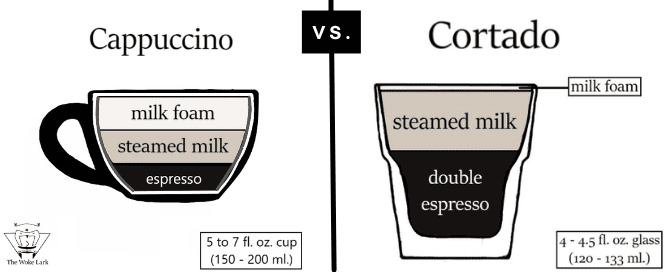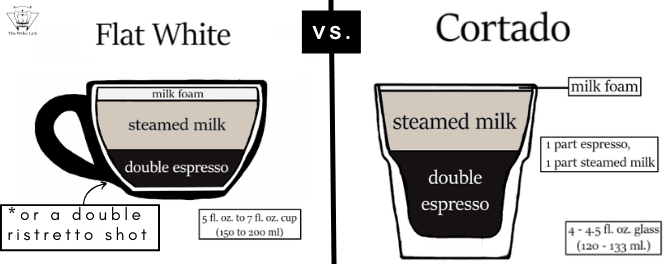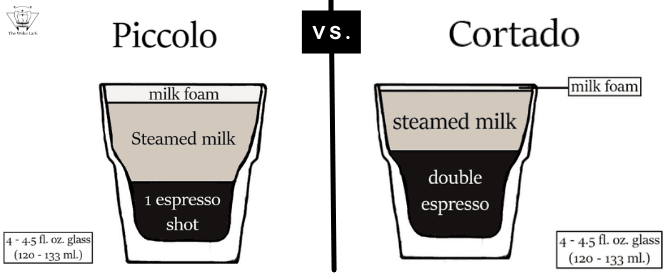Coming from Spain, most likely Madrid, the cortado has spread rather quickly and can now be found at virtually any coffee shop.
Even though you can’t find it listed on the Starbucks menu, once you learn its ingredients it will be easy for you to order one (and it’d be totally worth it).
But not all coffee lovers know what a cortado is and how it’s made.
Even if you’re a passionate coffee connoisseur, you may struggle to pinpoint the differences between a cortado and a caffè latte.
If that’s the case, don’t worry!
In this drink guide, I will give you a simple cortado definition and compare this Spanish beverage to other classics, such as the flat white, cappuccino, macchiato, and piccolo.
Let’s dive in!
What is a Cortado: Definition
What I like about the cortado is how simple and balanced it is.
It gives you the best of both worlds – a rich espresso flavor, smoothly balanced with just the right amount of steamed milk.
Not too diluted and not too intense.
But let’s get to the point: here’s what a cortado is by definition:
A cortado is an espresso-based coffee beverage, made of equal amounts of espresso and steamed milk.
Traditionally it’s prepared with a double espresso shot (around 2 fl.oz., 60 ml.), and 2 fl. oz. (60 ml.) steamed milk.
A cortado is served in a 4.5 fl. oz. (133 ml) glass that’s also known as Gibraltar glass.
It is often topped off with latte art and has a very thin microfoam layer.
The word ‘cortado’ actually means ‘cut’ in Spanish.
Figuratively speaking, the espresso is cut with steamed milk.
The way the cortado is made and served varies from one coffee shop to another.
At some locations, it’s made with a single espresso shot instead of a double.
Nevertheless, the proportions remain the same – 1:1 espresso-to-steamed milk.
At other coffee shops, the cortado has quite a thick milk foam layer.
To be fair, I prefer this Spanish drink prepared with little to no foam – as it’s traditionally made.
For a more intense coffee flavor go for their regular espresso roast.
If you want to have a cortado with a more complex flavor profile and pleasant coffee acidity, ask the barista to prepare it with the Starbucks® Blonde Roast.
Some coffee shops around the world offer flavored and iced cortado drinks.
For example, at Costa you can get a caramel or mocha cortado.
The aforementioned drinks are prepared with flavored syrups and sauces.
Costa’s iced cortado is a small coffee drink made of espresso, shaken with ice and milk.
Cortado vs. Caffè Latte: The Difference
There are quite a few differences between a cortado and a caffè latte.
Unlike cortado coffee, the caffè latte is usually prepared with a single, not a double espresso shot.
Expectedly, the former contains more caffeine.
A latte is served in an 8 to 12 fl. oz. (240 to 350 ml.) cup, so it’s at least twice as large as a classic cortado.
A cortado coffee has a more pronounced coffee flavor since the caffè latte contains more milk and less espresso.
Another difference between these two is that the latter has a thicker milk foam layer.
You can check out a cortado vs. latte side-by-side comparison, illustrated in the following picture:
The caffè latte actually has more things in common with the cappuccino.
So let’s have a look at this classic Italian beverage and how it compares to its Spanish cousin.
How Does a Cortado Compare to a Cappuccino?
The cappuccino contains more frothed milk than a cortado and a caffè latte.
So if you’re a fan of airier coffee drinks with more texture, the cappuccino may be more suitable for you than a cortado.
Compared to a cortado, the cappuccino contains less caffeine, as it’s usually prepared with a single, not a double espresso shot.
As you may have guessed, the coffee flavor of the Spanish espresso-based beverage is more intense.
Actually, if you feel like having a double espresso with a larger amount of milk (in a larger cup), go for a flat white.
You can see the flat white versus cortado comparison, illustrated in the picture below.
Cortado vs. Piccolo
The piccolo (also known as piccolo latte) is another espresso-based coffee beverage that is served in a small 4.5 fl. oz. (133 ml.) Gibraltar glass.
Compared to a cortado, a piccolo latte contains less espresso (a single shot, not a double), more milk foam, and a slightly higher steamed-milk-to-coffee ratio.
How to make a Cortado?
To make a cortado without an espresso machine, I recommend using 2 fl. oz. (60 ml.) of coffee brewed in a Moka pot.
This style of brew is the best alternative to espresso for homemade lattes, cappuccinos, cortados, and other espresso-based beverages.
If you don’t own a Moka pot, just prepare a 2 fl. oz. (60 ml) of coffee with a higher coffee dose.
The higher dose will result in a stronger brew which will better mimic the intensity of espresso.
Using a dark coffee roast will also contribute to a bolder brew with a heavier body.
After preparing your coffee, place a bit of milk in a saucepan over medium heat.
Allow it to heat up gently for about 3-4 minutes.
Pour the coffee into a Gibraltar glass and then add the milk.
It’s that easy!

Click here to check out the price of the glass above on Amazon.
Of course, if you want an authentic cortado experience, you can’t really get it without using an espresso machine.
So go to a local coffee shop and have it prepared by a professional barista to truly sense what this beverage is all about.
Final Words
I hope that you found my coffee drink guide helpful.
Next time someone asks you what a cortado is, you’re going to answer confidently.
It’s not that it’s hard to memorize what defines this Spanish beverage.
It’s just that there are so many coffee drinks you can choose from – cappuccinos, flat whites, macchiatos, lattes, etc.
So one can easily get intimidated and confused.
Knowing what sets these beverages apart would be useful to anyone who orders coffee on a daily basis.
With all being said, leave me a comment below if you have any questions.

